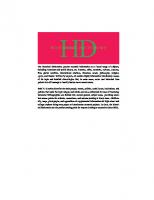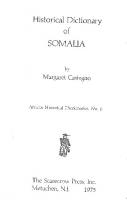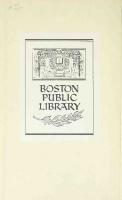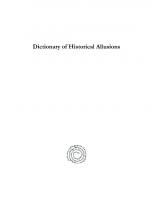Historical Dictionary of Guinea (Republic of Guinea/Conakry) 081081112X, 9780810811126
442 103 6MB
English Pages 157 [198] Year 1978
Recommend Papers

- Author / Uploaded
- Thomas E. O'Toole
File loading please wait...
Citation preview
Historical Dictionary of GUINEA (Republic of Guinea/Conakry)
THOMAS E. O’TOOLE
-
Historical Dictionary of GUINEA (Republic of Guinea/Conakry)
by
THOMAS E. O’TOOLE
African Historical Dictionaries, No. 16
The Scarecrow Press, Inc. Metuchen, N.J. & London 1978
Library of Congress Cataloging in Publication Data O'Toole, Thomas, 1941Historical dictionary of Guinea (Republic of Guinea/ Conakry). (African historical dictionaries ; no. 16) Bibliography: p. 1. Guinea--History—Dictionaries. 2. Guinea-Bibliography. I. Title. II. Series. DT543.5.088 966'.52'005 77-28145 ISBN 0-8108-1112-X
Copyright © 1978 by Thomas E. O'Toole Manufactured in the United States of America ii
for Ann, Rachel and Phillip with love
ACKNOWLEDGMENT
I have to thank a number of people for making this book possible. In the first place my wife, Ann, was devoted and tireless in preparation of the bibliography. My daugh¬ ter, Rachel and son Phillip, bore up well to life with an often preoccupied father. Professor Ed Cohen and Ms. Naja Williams of Hunter Library at Western Carolina University were most helpful. Two other friends also gave invaluable assistance. Janice Baker, a former resident of Guinea, now at the Library of Congress, helped me in checking post-1970 materials. A Guinean friend, Dr. Lansinfe Kaba, now at the University of Minnesota, gave considerable insight into the present-day actualities in Guinea. Finally Lynda Morgan, Cathy Elrod, Susan Gordon Reid and Sharon Rothrock at Western Carolina University aided in arranging the bibliography and typing the manuscript. T. O. Cullowhee, North Carolina May, 1977
IV
CONTENTS
Acknowledgment
iv
Editor’s Foreword (Jon Woronoff) Note on Spelling
vii ix
Abbreviations and Acronyms
x
Chronological List of Major Events
xii
Introduction
xvii
Tables 1 Estimated Agricultural Production 2 Estimated Mining Production
xxv xxvi
The Dictionary
1
Bibliography Introductory Essay Abbreviations in the Bibliography A Note on the Scope 1 General Works 2 Early Historical and Exploration Accounts 3 Historical Studies 4 Anthropology, Ethnology and Sociology 5 Contemporary Politics 6 Economics 7 Education 8 Scientific Studies 9 Religion 10 Literature and Poetry 11 Linguistics 12 Art and Music 13 Tourism 14 Reference and Bibliography
v
79 80 81 83 86 88 97 112 124 132 134 147 148 151 151 153 153
-
'
EDITOR’S FOREWORD
Few African countries entered independent nationhood with such great promise as Guinea, and few leaders aroused an enthusiasm as great and wide-spread as Sfekou Tourb. The first Black African colony to break its bonds with France, its first leader to resolutely embrace nonalignment, and the first regime to openly proclaim socialism, Sfekou Tour&'s Guinea appeared as a natural leader to many, espe¬ cially among the young and radical. Two decades later, independence, non-alignment, and socialism are still proclaimed stridently and broadly, and have even been implemented ... in a Guinean fashion. But there is no echo. Guinea’s experiment has hardly been a suc¬ cess in the eyes of its detractors, its competitors, and even often in its own terms. But its biggest failure would seem to be that neither its supporters nor its opponents take it seriously any more. Guinea has ceased being a model and become a backwater, remembered only after some spectacu¬ lar and, more often than not, violent event. What then has been happening in one of Africa's once best-known countries, now hardly possible to stay informed about even through the specialized press and journals? Col¬ lecting the information was not an easy task, despite the author's familiarity with Guinea. And telling this story with¬ out the blind optimism or the disgust that often color much of the writing about, or from, Guinea is indeed an achieve¬ ment. Dr. Thomas O'Toole went to Guinea with the Peace Corps for about two years in 1963-1965, one of the most exciting periods in modem African history, when unity ap¬ peared around the corner and fraternity had a deep meaning. These were also years when Sfekou Tourfe's thought and ac¬ tion influenced much of the continent. Since then, through personal contacts and other sources, he has continued to fol¬ low the country's more somber path. Expanding on a short vii
book and his Encyclopaedia Britannica entry on Guinea, Dr. O'Toole in this dictionary gives us a rare glimpse of the present situation. Jon Woronoff Series Editor
viii
NOTE ON SPELLING
We are far from possessing a standard orthography for most of the indigenous languages of Guinea and only since independence has there been any real attempt to standardize spellings. The fact that French, Portuguese and English variants for many terms exist along with different forms in the various African languages of Guinea only compounds the difficulty. A single ethnic group, the Fulbfe, can be labeled Peul, Fula or Fulani depending on the source. Since Peul is the singular and Fulbfe is the plural used by Fulfuldfe (Fulbfe speakers) for members of this ethnic group, they will be identified herein as Fulbb. Generally agreed spellings of names and terms will usually be used even when they are not linguistically correct. When widely divergent spelling varieties exist the various forms will generally be given, with the most common term given first.
IX
ABBREVIATIONS AND ACRONYMS
Afrimar AGF AGP AOF BAG BCEAO BCRG BGCE BNDA BPN CAP CBG CC CER CFA CFAO CGCE CGCI CGT CMR CNE CNF CNPA CNR CNTG COPAC CUP DSG ESA FEANF FIDES
Societe Africaine des Peches Maritimes Association des Guinfeens en France Agence Guinfeenne de Presse Afrique Occidentale Frangaise Bloc Africain de Guinfee Banque Centrale des Etats de l’Afrique de l'Ouest Banque Centrale de la Rfepublique de Guinfee Banque Guinfeene de Commerce Exterieur Banque Nationale pour de Dfeveloppement Agri¬ cole Bureau Politique National Cooperative Agricole de Production Compagnie de Bauxites de Guinfee Comitfe Central Centre d'Education Revolutionnaire Communaute FinanciSre Africaine Compagnie Frangaise de l'Afrique Occidentale Comptoir Guineen du Commerce Exterieur Comptoir Guineen du Commerce Interieur Confederation General du Travail Centre de Modernisation Rurale Caisse Nationale d'Epargne Comite National des Femmes Centre National de Production Agricole Conseil National de la Revolution Confederation Nationale des Travailleurs Guineens Cooperative de Production Agricole et de Consommation Comite d'Unite de Production Democratic Socialiste de Guinee Ecole Superieure d'Administration Federation des Etudiants de l'Afrique Noire en France Fonds d'Investissement pour le Developpement Economique x
xi FLNG HAL CO IBA I FAN INRD IPC JORG JRDA MIFERGUI OAU OCA ON CFG PAIGC PDG PPG PRC PRL PZ RDA SCOA SFIO SIAG SIP SNA SOGUIP Sonigue Soguikop UGTAN
Abbreviations /Acronyms
Front pour la Liberation Nationale de Guinee a consortium formed by Harvey Aluminum Company Association Inter-Gouvemementale des Pays Producteurs de Bauxite Institut Frangais d'Afrique Noire Institut National de Recherches et de Documen tat ion Institut Polytechnique Gamal Abdel Nasser de Conakry Journal Officiel de la Rfepublique de Guinfee Jeunesse de la Revolution Democratique Africaine Societe des Mines de Fer de Guinee Organization of African Unity Office de Commercialisation Agricole Office National des Chemins de Fer de Guinee Partido AfricSo da Independence da Guine e do Cabo-Verde Parti Democratique de Guinee Parti Progressiste de Guinee People's Republic of China Pouvoir Revolutionnaire Local Paterson-Zochonis Rassemblement Democratique Africain Societe Commerciale de l'Ouest Africain Section Frangaise de l'Intemationale OuvriSre Societe Industrielle et Automobile de Guinee Societe Indigene de Pr6voyance Societe Nationale d'Assurance Societe Guineenne de petrole Societe Nippo-Guineenne de P§che Societe Guineo-Koweitienne de Peche Union Gen6rale des Travailleurs d'Afrique Noire
CHRONOLOGICAL LIST OF MAJOR EVENTS
920-1050
Guinea is part of Empire of Ghana
ca.
Sundiata Keita, King of Mali
1235-1255
1240
Sundidata destroys Ghana
1307-1332
Kankan Mansa Musa, ruler of Mali
1324
Kankan Mansa Musa's pilgrimage to Mecca
1470
Benedetto Dei, a Florentine, visits Tim¬ buktu
early 1500's
Fulbh begin to arrive on the Futa Jalon plateau
1513
505 slaves sent from Guinea to Portugal
1514
978 slaves sent from Guinea to Portugal
post-1542
French privateers active on the Guinea coast and attack Fogos Island
1594
Moroccan army ends Songhai Empire
ca. 1622
3000 slaves sent annually from Guinea to Portugal
July 1687
English factory established at Rio Nhflez
1714
French Senegal Co. sets up factories on the Guinea Coast
ca. 1725
Karamoko Alfa and Ibrahima Sori began Jihad in Futa Jalon
1768
Moravian missionaries arrive on Guinea coast
1795-1797
Mungo Park reaches Sfegu and the Niger from Gambia
ca. 1800
Muslim state fully established in Futa Jalon
1808
British establish a naval patrol against slave traders in West African waters xii
xiii
Chronology
1824-1826
Renfe Caillfe leaves Senegal to explore to Timbuktu
1842
French treaties with Landouma and Nalou leaders in Guinea
ca. 1850
A1 Hajj Umar attacks Bambara kingdoms of Sfegou and Kaarta from Dinguiraye in the Futa Jalon
1854
the jihad of A1 Hajj Umar begins
Aug. -Sept. 1860
French force A1 Hajj Umar to retire to the Niger
1866
France acquires trading centers on Guinea coast
1868
French posts established at Bokfe and Benty
1880
French obtain railway concession in Guinea from some Fulbfe leaders
1881-1899
French expeditions against Samory Tourfe
June 28, 1882
Anglo-French agreement on Sierra Leone and Guinea boundaries
May 12, 1885
Franco-Portuguese Convention on Portu¬ guese Guinea and French Guinea bound¬ aries
1890-1894
French explorations in Guinea
March 10, 1893
French colony of Guinea is officially es¬ tablished
June 15, 1895
AOF established
April 8, 1904
a further Anglo-French convention on French Guinea boundaries
Nov. 5, 1904
Franco-Portuguese treaty on Guinea bound¬ aries
1905
a number of anti-colonial struggles in French Guinea are in progress
Sept. 18, 1907
Franco-Liberia agreement on LiberianFrench Guinea borders
Dec. 4, 1920
AOF reorganized
March 30, 1925
Africans are elected to Conseils d'Admin¬ istration in Guinea
Dec. 7, 1942
AOF joins the Allies
Chronology
xiv
Jan. 30-Feb. 8, 1944
Brazzaville Conference
Nov. 4, 1945
Yacinfe Diallo from Guinea elected to repre¬ sent AOF in French constituent assembly
April 11, 1946
corvfee abolished in AOF
May 7, 1946
French citizenship with a limited franchise given all AOF subjects
Oct. 18, 1946
RDA founded in Bamako with PDG as a section
1952
Sfekou Tourfe becomes Secretary-General of the Guinea branch of the RDA
1956
PDG-RDA sweeps elections as Sfekou Tour& is returned to National Assembly in Paris
Sept. 28, 1958
Guineans reject De Gaulle constitution by 1,136,324 to 56,981 votes
Oct. 2, 1958
Guinea becomes an independent republic, with Sbkou Tour§ as President
Jan. 15, 1961
nationalization program starts with take¬ over of power and water supplies
Nov. 1961
"Teacher’s Plot" put down; Daniel Solod, Soviet Ambassador, expelled
Nov. 22, 1965
diplomatic relations with France broken off following October plot allegedly backed by French
March 2, 1966
Kwame Nkrumah of Ghana offered asylum and offered honorary co-presidency
Feb. 1969
the "Labfe plot": 13 sentenced to death, 27 imprisoned for plotting against Sfekou Tourfe
June 24, 1969
assassination attempt on Sfekou Tourfe dur¬ ing visit of President Kenneth Kaunda of Zambia
Nov. 2, 1970
Portuguese and Guinean exiles try to take Conakry; they fail, 92 are condemned to death and 66 to hard labor for life
Jan. 24, 1971
diplomatic relations broken with Senegal, and on Jan. 29, 1971, with West Ger¬ many, on grounds that they had taken part in abortive Conakry invasion
XV
Chronology
Feb. 1971
series of visits from heads of states starts with President Ngouabi of Congo-Brazzaville
April, 1972
President Sfekou Tourb unanimously re¬ elected president at the PDG's Ninth Congress
May 9, 1975
diplomatic relations with West Germany resume after a five-year lapse
July 14, 1975
diplomatic relations with France resume
July, 1975
Tourfe makes state visits to Upper Volta and Mali
Jan. 1976
Guinea agrees to participate in the Second World Black and African Festival of Arts and Culture in Lagos
Sept
Tourfe interprets Koran as supporting the PDG on Guinean radio
1977
—-X^r^Uo
\
Wesr Africa
Introduction xvi
INTRODUCTION
The origin of the name Guinea itself is obscure. Some suggest that Guinea might be derived from the ancient Niger Basin trading center, Jennb. More likely it derives, through Portuguese usage, from the Berber Akal-n-Iguinawen or ’’Land of the Blacks." Yet another possibility is that it comes from the word geenay, meaning "women" among the coastal Susu, and somehow this name came to be applied to a widespread area of the African coast. The modem Republic of Guinea faces southwest to the Atlantic on the western extension of Africa between 8° and 12° north latitude. Guinea touches on six other African na¬ tions; clockwise north to south they are Guinea-Bissau, Sene¬ gal, Mali, Ivory Coast, Liberia, and Sierra Leone. Guinea is traditionally divided into four natural regions: (1) Lower Guinea (the coastal areas); (2) Middle Guinea which consists chiefly of the highlands of the Futa-Jalon, inland from the sea; (3) Upper Guinea, which descends gradually northwest towards the Sahara desert; and (4) the Forest region which stands astride the watershed between the Niger river drain¬ age plains and southward flowing rivers which exit to the Atlantic through Liberia and Sierra Leone. Climatically all of Guinea shares two alternating sea¬ sons: a dry season (November to March) and a wet season (April to October). Rainfall varies from region to region with as much as 170 inches a year at Conakry on the coast to less than 60 inches a year in Upper Guinea. The rain¬ fall in Middle Guinea ranges from 63 to 91 inches a year while some areas in the Forest Region have more than 100 inches of rain a year. Temperate ranges also vary accord¬ ing to the different regions. On the coast and in the forest region the temperature ranges around an average of 81° Fahrenheit. While the Futa highland of Middle Guinea may experience January daytime temperatures from 86° F to 95° F nightime temperatures may dip below 50° F. Midday highs of more than 100° F are not uncommon in Upper Guinea dur¬ ing the dry season. xvii
Introduction
xviii
XIX
Introduction
The natural drainage system includes the Niger River and its two main tributaries, the Tinkisso and the Milo in Upper Guinea. In the Futa highlands both the Senegal and the Gambia have their sources as well as the Rio Nfifiez, Konkourfe, Fatala and the Melikourfe, which flow southwest to the Atlantic. Flowing more southerly through Sierra Leone and Liberia a number of minor rivers drain the For¬ est Region boundary area. Most of Guinea is composed of savanna grasslands and orchard shrub with soils largely composed of silicates of aluminum hydrate except along rivers and the tidal areas. Major food crops include millet, maize, rice, manioc (cas¬ sava) and oil palms while some coffee and bananas are cul¬ tivated for export. Guinea’s estimated population of around five million is composed of a variety of ethnic groups. The present day boundaries of Guinea were determined by colonial powers with little regard to the ethnic or linguistic groupings of African people. These boundaries, therefore, often split ethnic and linguistic groups. Within the country, though, the four major geographic regions largely correspond to four ma¬ jor ethnolinguistic groups. In Lower Guinea Susu, a Manding language, closely related to the Dialonkfi language of Middle Guinea, has largely replaced that of the Landoma, Baga, Nalou and other West Atlantic languages once widely spoken in the coastal areas. In the Futa Jalon of Middle Guinea the Fulbfe language is dominant, although minor in¬ digenous ethnic groups like the Badyarankfe, Bassari and Coniagui, and Manding speaking immigrants like the Dialonkfe and Diakhante continue to maintain some of their traditional ways. Maninkakan, the language of the Maninka, is widely spoken in Upper Guinea, and has long been penetrating into the Forest zone where three very different linguistic groups still are dominant. These three linguistic areas, from east to west, are the Kpelle (Guerzfe), Loma (Toma) and Kissi. A number of other minor ethnic groups exist in Guinea but the process of creating a national identity in Guinea has made considerable headway since independence. As President Tourfe has suggested, ethnicity should not be denied but it should also be obvious that no ethnic group will survive if Guinea perishes because of inter-ethnic rivalries. The growth of the whole national community has largely taken priority over ethnic particularism in Guinea. Based on official Guinean census figures the popula-
Introduction
xx
tion density of Guinea in the early 1970's was almost 54 per¬ sons per square mile. But given the nature of the slashand-burn subsistence farming which still prevails throughout much of Guinea and the persistent need for the importation of food, it is unlikely that these figures are very accurate. The administrational regions of Labfe and Pita in the Futa Jalon, both having agreeable climate and fairly good soil conditions, probably has over 100 persons per square mile. In the forest region the rich agricultural areas around Gu&kfedou and Nzferfekorfe may also have maintained populations in excess of 90 persons per square mile. But Upper Guinea, encompassing two-fifths of Guinea's total territory, has about 27 people per square mile. Except in fertile areas along the Niger and Milo Rivers the large stretches of savanna and savanna woodland in Upper Guinea are very lightly inhabited. The Conakry, Dubrfeka and Fria regions in Lower Guinea have more than doubled their population in the past twenty years as bauxite mining, bauxite processing and other industries have grown. Conakry and its suburban environs on the Kaloum peninsula has over 4400 people per square mile, while Fria and Dubrb have more than 90. It would seem that un¬ even urbanization of this sort could create social, political and economic problems for Guinea in the future. The pre-colonial history of Guinea still remains rather incomplete. Though archeological research in Guinea has not made much progress, evidence seems to indicate that the area has been continuously inhabited by hunting-and-gathering populations for at least the past 30,000 years. It also seems probable that farming has been practiced in the area of Guinea for at least the past 3000 years. There is consider¬ able evidence that iron smelting dates back more than 2000 years in this part of West Africa. But until further arche¬ ological evidence is forthcoming, much of the early history of Guinea remains conjectural. The pre-colonial history of Guinea becomes much clearer from about A. D. 900 as sources in Arabic and oral traditions become available. Travelers' accounts in Arabic and professional history keepers' oral narratives offer in¬ formation on the genealogies of royal families and traditions of ethnic groups who lived in Guinea in the past millenium. For peoples like the Coniagui, Baga, and Nalou, who now live on the Atlantic coast, ethnological evidence supports the view that they lived in the area of modern Guinea even be¬ fore the Christian era. Others, like the Susu and Maninka, probably came into the area about A. D. 900, while the Fulbfe
xxi
Introduction
who arrived in large numbers in the 17th century, are al¬ most newcomers. Much of Upper Guinea's pre-colonial history is closely tied to the three great centralized savanna states of West Africa—Ghana, Mali, and Songhai--which dominated the lands to the north and east of modern Guinea from about A. D. 1000 to the mid-16th century. Villages and small kingdoms of the Maninka people located on the headwaters of the Niger River began to achieve historical prominence in the 13th cen¬ tury. The gold fields of Burfe near modern Siguiri greatly contributed to the wealth of all the trade based empires of the western savanna but were certainly very important to the Mali Empire. Oral traditions maintain that the powerful empire of Ghana, which dated from at least the eighth century, forced the towns and villages of Upper Guinea to pay equal weights in gold for the salt that had to pass through Ghana from des¬ ert mines in the north. Oral historians or griots maintain that about A. D. 1235 a popular and effective leader, Sundiata Keita, united the various Maninka villages and groups and defeated Sumanguru, an especially oppressive Susu war lead¬ er who had gained control of the old Ghana empire around 1200. Sundiata was probably born in a Maninka village in¬ side Guinea’s present boundaries. With the decline of the Mali Empire in the late 14th century new forces began to control the area of modern Guinea. In the late 15th century, Coli Tenguela (or Temala), a Fulbfe leader, conquered the Futa Jalon with a small num¬ ber of followers. Originally from the central Senegal River valley, he passed through the Guinean towns of Tim bo and Labfe in his conquest. Because much of Coli Tenguela’s con¬ quest was accomplished by using local populations as troops, the number of Fulbfe involved was never large. The only long-term effect of these conquests was to push Susu and Maninka groups to the coast where they often established themselves as rulers over the local peoples. These coastal areas were drawn into European market systems from the mid-15th century on. Local rulers on the coast began to grow in power by recruiting members to their groups with the promise of imported trade goods. Though not one of the major slave trading areas of West Africa, Guinea was affected by the wars and disruption occasioned by this trade. By the end of the slave trade in the early 19th century, European trade goods had replaced many types of locally produced goods. Consequently the French and
Introduction
xxii
British commercial interests which had achieved dominance on the coast were poised to intervene even more deeply in internal African affairs. It should not be supposed, though, that British and ultimately French trading interests played a very important role in the Guinean interior before the mid-19th century. At the end of the 17th century, increasing numbers of Fulbfe cattlekeepers had moved into the Futa Jalon. Upset at pay¬ ing taxes to the non-Muslim residents of the area the Fulbfe created a theocratic Muslim state in the Futa Jalon. This state itself was torn by internal dissent until the French oc¬ cupied the Futa Jalon in 1897, but it firmly established the Islamic theory of a God-ruled state in the minds of many Guineans. In 1826, a young Muslim religious leader from the Futa Toro in upper Senegal returned to West Africa. This man, A1 Hajj Umar, settled in the Futa Jalon and began teaching a simple, devout form of Islam--the Tijaniyya. Ex¬ pelled from the Futa Jalon as a potential threat to the exist¬ ing Muslim state, he fled to Dinguiraye near the Burfe gold fields in Upper Guinea. From there he gathered forces and launched an attack on the Bambara states to the east. After his death internal revolts and French pressures destroyed his forces. Not all African leaders were as easily defeated by the French. Almany Samory Tourfe, a Guinean Maninka lead¬ er, had proposed alliance against the French with Umar's son, Ahmad in 1883 or 1884. Though Ahmad defeated this alliance, the story of Samory remains an important part of Guinean history. The first president of Guinea, Ahmed Sfekou Tourfe, claimed descent from Samory and Guinean school children are taught that Samory was a forerunner of national independence because of his determined resistance to the French. As the leader of an independent Maninka state in southeast Guinea from 1882 until 1898, he did provide the French with more military resistance than they had bargained for. Unfortunately, the French had the greater sources of supply. Samory was never able to obtain enough modern weapons to resist the French in the long run. His efforts at unification with other African leaders failed because these other leaders did not see as clearly as he the growing threat the French posed to African autonomy. Samory was captured by the French in 1899 and exiled. Belatedly and in isolation, small groups of Africans continued to resist the French until
xxiii
Introduction
the end of World War I but treaties with Great Britain and Liberia had by then already established the boundaries of colonial French Guinea. French rule brought some important changes in the social and political structure of African society. Largescale African polities were replaced by a French administra¬ tive structure. Private ownership of former communal land and the expansion of commercial and service occupations re¬ sulted in the development of civil servants, teachers, small shops and plantation owners, medical and military personnel and transportation. Gradually an urban elite evolved which adapted the French language and culture. But the majority of Africans continued to live in villages and practice sub¬ sistence agriculture well into the 1940s. After World War II political activities among this French educated elite grew. Ethnic-based parties and af¬ filiates of parties in France were to dominate. In the 1950s the Parti Dfemocratique de Guinfee, a new labor-based party founded in 1947, began to mobilize the support of the peas¬ ants, youth and women. It was this party, under the leader¬ ship of S6kou Tourfe, that lead the Guinean people to vote against General De Gaulle's proposed French Community in the referendum on September 28, 1958. On October 2, 1958, Guinean independence was formally proclaimed. Cut off from budgetary assistance and the favored-nation status of Guinean exports to France, faced with a shortage of trained administrators, teachers, military staff and medical person¬ nel, Guinea began independence with no resources other than a highly enthusiastic and hopeful population. The strong unifying force of a charismatic leader and a popularly based party in the early years of independence succeeded in over¬ coming interpersonal conflicts, the difficulties of rising ex¬ pectations among the small Guinean elite, ethnic cleavages and the great lack of economic resources and infrastructure for development. Over the first ten years of independence, Guinea con¬ tinued to occupy a special position among African states in its unqualified rejection of colonial control or economic dom¬ ination by more developed nations. Taking a militant panAfricanist stance in African affairs, one of "positive-neutral¬ ism" in the cold war, and combining a unique articulation of African socialism and "cultural revolution" in internal affairs, Guinea, under the leadership of S6kou Tourfe, presented an image of radical experimentation in social and political de-
Introduction
xxiv
velopraent in Africa. Unfortunately the rate of economic de¬ velopment was rather slow and from 1960 on a number of attempts have been made to overthrow the government of Sfekou Tourfe by assassination, coup d’fetat and invasion. In April 1960 a plot to overthrow the government by armed force was alleged by PDG agents. The instigators of this plot were apparently Guinean citizens who resented the anti-capitalist socialist thrust of the PDG regime. In No¬ vember 1961 Tourfe accused the Soviet embassy of supporting a teacher's strike, which was crushed with considerable severity. In late 1965 leaders of a group seeking to form an opposition party were arrested and charged with plotting to bring about the downfall of Tourfe's government. In Feb¬ ruary 1969 the army was purged along with other dissidents in the Party and in June 1969 an apparent assassination at¬ tempt on Tourfe, blamed on an exile opposition group, was almost successful. In November 1970 a seaborne invasion of the capital, Conakry, launched by Portuguese troops and Guinean exiles proved abortive. Another purge of the Guinean political and administrative elite followed. In July 1971 the army's officer corps was similarly purged and in April 1973 a number of cabinet ministers were accused by President Tourfe of plotting to overthrow his government. Such purges and accusations have become increasingly com¬ monplace in recent years. Guinean groups made up of pre -independence opponents of the PDG, former PDG officials who have deserted the re¬ gime, professionals, businessmen, dissident military leaders, ex-servicemen, academics and students along with migrant Guinean traders and laborers do form substantial external forces in opposition to Sfekou Tourfe. Based mainly in France, Senegal and the Ivory Coast, they represent a number of fac¬ tions and could possibly have played a role in some of the at¬ tacks on President Tourb and the present government of Guin¬ ea. Internal opposition has been all but silenced. Smuggling and black-market activities continue to op¬ erate to some extent as a result of the PDG regime's failure to promote economic growth. The majority of Guineans de¬ sire a better standard of living, yet are probably quite proud of the Guinean nation even though the rule of the PDG, sup¬ posedly a popular dictatorship based on the will of the people, has become increasingly restrictive and centered in the person of the "Doctor of Revolutionary Science" and the Terror of In¬ ternational Imperialism, of Colonialism and Neo-Colonialism, President Ahmed Sfekou Tourfe.
o O
O O
c- o
o 05
6
■X
O CD CD Tt*
CO C -in O L—H (D d CD G X 73 a* O SH
HCOOMO't1 CO CO CO (M
LO O O 05 (M CO N CO CO


![Historical dictionary of Democratic Republic of the Congo (Zaire) [revised]
0810835711, 9780810835719, 9780585104614](https://ebin.pub/img/200x200/historical-dictionary-of-democratic-republic-of-the-congo-zaire-revised-0810835711-9780810835719-9780585104614.jpg)






